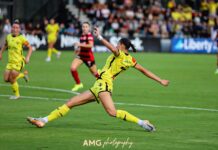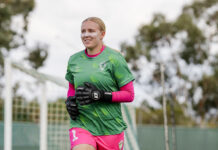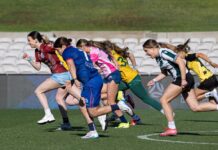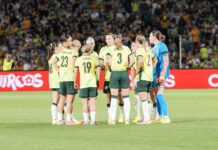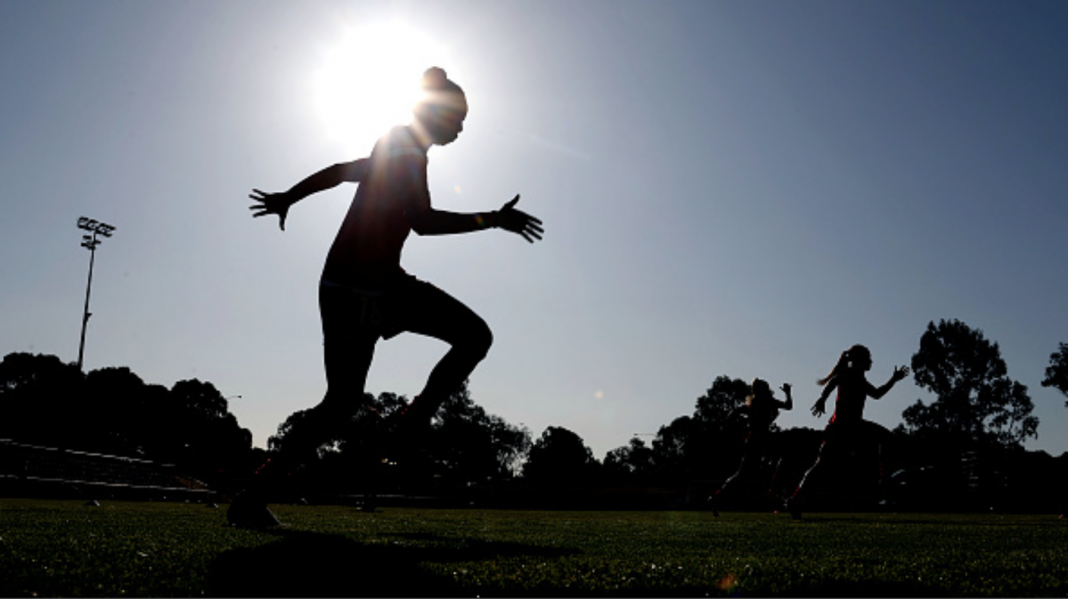
All 14 rounds of the 2019-20 edition of the W-League season have been played, and Beyond 90 are here to go over how each team fared in Season 12. In this article, teams finishing outside the top four (and not contesting finals) are looked at.
5th: Brisbane Roar – Potential not quite realised
Written by Nick Amies
The Roar missed the finals for the first time since 2016-17, ultimately falling short in the final round of the season.
Needing a result against the undefeated Melbourne City and for one of the other matches to go their way, Goodship’s side ultimately couldn’t overcome the premiers at AAMI Park.
Brisbane perhaps fell victim to the W-League’s lack of a full home-and-away season, facing the eventual top four in 7 of their 12 matches, including playing City twice in their last six games.
By contrast, Sydney FC and Western Sydney Wanderers played against ‘top-five’ teams in six matches each, with both clubs only facing Melbourne City once during the season.
In addition, consecutive losses to start things off meant that the team in orange were forever playing catch-up on their finals rivals.
In the end though, you simply have to beat the teams in front of you, and a shock loss in round 12 to Perth would in hindsight be where the telling blow was dealt on their finals chances.
Young stars Hollie Palmer and Indiah-Paige Riley have undoubtedly shown their potential for future W-League seasons, but the team lacked a regular goal threat next to Hayley Raso.
The Matildas star finished top scorer for the season with four, despite only playing two-thirds of the campaign, followed by Rylee Baisden, Tameka Yallop and fullback Carson Pickett on three apiece.
Despite comfortably leading the league for shots on target, the Roar had the third-lowest conversion rate on these chances.
The Roar will look back on what might have been this season, with a 4-0 thumping over Western Sydney Wanderers hinting at the potential this side could have reached under the right conditions.
6th: Canberra United – Tough Run Home
Written by Steffen Moebus
When last we left off, Canberra United was perched promisingly on the edge of the top four on goal difference, with a tough run home to come including key away matchups against finals rivals Melbourne Victory and Brisbane Roar, but with one less game to play compared to most teams.
It didn’t quite go the way the team would have hoped. A horror month from Boxing Day saw three 4-0 losses followed by a 3-0 loss to Victory. Then came the curiously timed announcement two weeks from finals that the club had opted to not renew coach Heather Garriock’s contract at the end of the season. An emotion-charged last home game saw the team respond well with a 3-1 win against Adelaide, but frailties were exposed again in the final game with a heavy 5-0 loss away to the Roar.
Each blowout came after the team in green decided to chase the game after being a goal or two down, pushing forward without reward but leaving gaps in behind for their opponents to exploit. Mirroring her playing days, it can never be said that Garriock went down without a fight.
This goes some way to explaining why the ‘Goals Against’ column belies the perception of solid seasons for the defensive cohort of ‘Player of the Season’ Kaleigh Kurtz along with Nikola Orgill, Jessie Rasschaert, and Matildas representative Karly Roestbakken.
In all, a somewhat disappointing end to a season that promised much with the recruitment of exciting international attacking weapons Simone Charley, Elise Thorsnes, Katie Stengel, and Camila alongside central defender Kurtz. Local NPL stars Rasschaert and Hayley Taylor-Young will look back fondly on their debut seasons, with the latter awarded as the club’s ‘Rising Star’.

7th: Perth Glory – Purple Patch in Vain
Written by Neil Bennett
Perth Glory’s mid-season revival proved too little too late, as their poor start to the season gave them too much to overcome, and the side followed the familiar pattern under coach Bobby Despotovski’s reign of Grand Finalists one year and also-rans the next.
Glory had a terrible start to the season, going pointless until the 5th round, when they drew at home against Canberra United, through a 90th-minute header from veteran Kim Carroll.
More losses followed, but in the 8th round, they earned their 2nd point when they drew with fellow cellar-dweller Adelaide United. They needed another last-minute equaliser, from the penalty spot this time, to earn the points but then only lost 2 games in the next 5, including convincing wins against Brisbane and Sydney FC.
The reason for the improvement was due to the team tightening up defensively, allowing them to counterattack more efficiently, which resulted in the spectacular goalscoring form of American import Morgan Andrews. She went on a goal spree in the second half of the season scoring 7 goals in total, becoming the joint Golden Boot winner in the process.
Andrews was undoubtedly the Player of the Year but was ably assisted by Spanish International Celia who scored 3 goals, and local forward Caitlin Doeglas who also bagged 3, and the team looked far more dangerous when those three were on the pitch together.
The season was ultimately a disappointing one for Perth, but their spirited showing in the second half gives some hope for the next campaign.
8th: Adelaide United – Missed Opportunities
Written by Molly Appleton
Again Adelaide United found themselves repeating history to fall short of the top four.
Despite a series of close matches with one-goal margins, Adelaide were unable to put points on the board until a thrilling round 7 2-all draw against Perth Glory.
United faced a harsh reality of conceding goals when concentration was lacking in matches of otherwise disciplined performances. The struggle to convert opportunities in front of goal was unable to rectify those frustrating moments.
While local talent consistently stood up, with Sarah Willacy, Chelsea Dawber and Dylan Holmes particularly impressive, it was two internationals who were standouts consistently throughout the season.
Amber Brooks backed up her 2018-19 W-League campaign to captain Adelaide and lead from the back with defensive stability and creative long balls forward. While Mallory Weber took the competition by storm, producing electrifying performances but was unable to find the quality finish to rack up the goal tally the forward deserved.
Holding onto the lead against a Western Sydney Wanderers side in the hunt for silverware was a significant boost in a difficult campaign. More importantly was perhaps a win in the final match of the season against fellow cellar dwellers the Newcastle Jets. The victory was essential to finish eighth on goal difference.
All eyes remain on a top-four finish for the future. Quality international recruitment could see the Reds replicate the Wanderers to crack into a finals berth. Otherwise, the team packed with exciting South Australian talent could possibly continue to remain just one or two world-class players from fulfilling their potential.
9th: Newcastle United – As Tough As It Gets
Written by Daniel Hanney
The Newcastle United Jets fans, coaches and players knew this season would be a tough one.
Built largely on local talent due to budget restrictions, the typical hard-working industrial, have a go attitude of the city would be required if Newcastle were any chance of giving the top teams a run for their money and they did. However, it wasn’t enough to avoid the club’s first wooden spoon since 2013/14.
The season started with promise, a gritty 1-1 draw with eventual invincible Premiers Melbourne City gave reason for hope.
Narrow losses followed, by the margin of just a single goal (1-0 v WSW & 3,2 v CBR) before notching their first win of the season, away to Perth Glory in round 4.
The pattern of narrow margins would continue throughout the campaign as the Jets inability to string passes together and control the ball lead to long periods of defence. The only blot a club record 7-0 defeat to Melbourne Victory in Round 13.
A 2-1 loss away to Adelaide United in the final round sealed their fate as winners of the unwanted wooden spoon but there were plenty of positives to be found:
Newcastle’s backline was arguably its strongest and most experienced in a long time.
Hannah Brewer and Cass Davis anchored the ship, flanked by captain Gema Simon and tireless young sensation Tessa Tamplin.
Behind them, Claire Coelho, who after spending the best part of five seasons on the bench took her chance to shine with both hands making a remarkable league-high 68 saves and cementing her spot as the Jets no.1 for the coming season and beyond.
This bullet at the back post from Teigan Collister levelled things up midway through the first half! #ADLvNEW #WLeague #MadeOfNewcastle pic.twitter.com/YCcx7i0oU4
— NEWCASTLE JETS FC ✈️ (@NewcastleJetsFC) February 27, 2020
Area for improvement?
Undoubtedly the Jets missed that extra key player with experience to help Clare Wheeler in the middle of the park.
At times she struggled and would get caught on the ball or play a misdirected pass because she simply didn’t have that quality around her that an Emily Van Egmond, Tori Huster and Arin Gilliland has provided in the past.
To combat this, all-time goal scorer Tara Andrews was moved back into midfield, as she was in the 2013/14 campaign, simply because she’s one of the best passers in the team.
By doing this, the Jets took away that tall, physical target striker outlet that has served them well over the past two seasons in the form of Katie Stengel.
Larissa Crummer continues to work hard on her rehabilitation from that horrific injury last season and could potentially fill the striker role next season, allowing Andrews to sit just in behind or up top alongside her. This along with the addition of another quality midfielder or two could see the Jets go from competitive to challenging for the finals once again.
Overall flashes of potential, an overall solid defence along with the unearthing yet more local talent was the silver lining to a frustrating campaign. The future is bright from Newcastle and the only way is up.
Read more W-League coverage.


